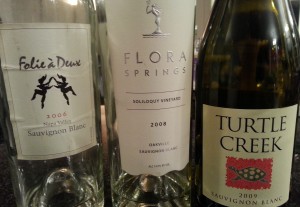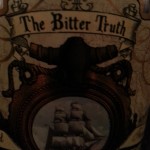This is a well thought-out presentation. The vodka is made from northern US wheat, and it has great elements: organic and sustainable agriculture, wind power and recyclable glass coated with organic inks and water-soluble varnishes. The colors are pale washes of red, white & blue. This is a big launch: branded bar tools from shaker to pourer, condiment tray, napkin caddy and even a fruit press.
But what’s in the bottle?
Tasted neat, the vodka is extremely smooth and even slightly sweet. When asked, the producers admitted there is some “organic flavoring” in the mix. Whatever that means. Anyhow, they admit it right on the bottle so it’s not a secret.
Speaking of mix, the spirit does meld well with many flavors, especially juices, which bodes well for cocktails. And it’s also mild and pleasant simply served on the rocks.
Oh yeah, where was the American Harvest Vodka Launch? I went to the event in Boston, in the delightful rooftop bar at Legal’s Harborside
Blog
A new wine list for a cause
The other night I went to an event that was so simple and fun I can’t believe every restaurant doesn’t do it: introducing the new season’s wine list with an inexpensive fund-raiser for The American Heart Association’s Go Red for Women. Because wine is good for the heart. The event was held at Abe & Louie’s in Boston.
Of course there was also bacon bar and a chocolate bar…which is what got me there. But I wasn’t driving, so I’m sure I consumed enough wine to offset anything I ate, heart-health-wise.
There was also an oyster bar, a cheese bar and a satay bar. These food bars were basically appetizer stations that were arranged with more imagination than the average event. The ingredients weren’t expensive, but the offerings were very appealing: on sticks, in vases, and with several vertical levels on each table. The chocolate was the simplest: giant blocks of very good quality milk, dark and white, shaved and chopped so you could scoop up as much as you wanted.
The evening’s menu listed suggested wine pairings. And the wine director and his assistant encouraged people to try both the whites and the reds on offer, with appropriately small pours. There were less than a dozen wines, a few more whites than reds, mainly from the US except for the prosecco from northern Italy and the Riesling from the Pfalz in Germany. Here’s the lineup: NV Avissi Prosecco, 2011 Duckhorn Sauvignon Blanc, 2011 Joel Gott “Unoaked†Chardonnay, 2011 Saint M Riesling, 2011 Summerland “Bien Nacido†Chardonnay, 2009 Gauthrier “Rocking H Vineyard†Pinot Noir, 2010 Noble Vines “181†Merlot, 2006 St. Supery “Dollarhide Ranch†Cabernet Sauvingon, 2010 Folie a Deux Zinfandel and 2010 Qupe “Central Coast†Syrah.
3 Robust American Sauvignon Blancs
 The other night while having people over for drinks, we opened three very good sauvignon blanc wines made in USA. Two from California, and one from Massachusetts (yes, MA!). We like them all. The wines were all somewhat different, and quite vigorous in nature – though one was much older than we realized at first.
The other night while having people over for drinks, we opened three very good sauvignon blanc wines made in USA. Two from California, and one from Massachusetts (yes, MA!). We like them all. The wines were all somewhat different, and quite vigorous in nature – though one was much older than we realized at first.
Beginning with the youngest, the 2009 Turtle Creek Sauvignon Blanc ($17) landed on the smoky side, with some nice acidity along with its green grass and herbal elements. A longish finish, too.
2008 Flora Springs Soliloquy Vineyard in Oakville ($18-20) showed classic aromas at first, that dissipated after a while, leaving us with a mild, crystalline tart-sweetness in flavor. It was a bit more neutral in flavor than the others – which was appreciated by many of the tasters. A longish finish, with a bit of umami too.
Somehow, I had put this bottle of 2006 Folie à Deux Napa Valley Sauvignon Blanc away for a rainy day, and only rediscovered it this week. It was an amazingly vigorous wine; no one would have guessed its age. Strong, grassy herbs dominated its aroma, with more green herbs in the flavor. A tinge of cocoa rounded out the end-palate and finish.
Don Quixote Wines — Castilla-La Mancha, Spain
 I can understand their calling it Don Quixote wine land because most people have heard of Don Quixote. But would I think to look up Castilla-La Mancha’s wine under this name? Not at first.
I can understand their calling it Don Quixote wine land because most people have heard of Don Quixote. But would I think to look up Castilla-La Mancha’s wine under this name? Not at first.
Speaking of firsts, I had a first real look at the Castilla-La Mancha wines the other day at a seminar in Boston. This is a region that has specialized in bulk wine that is used to color and flavor wines in other areas of Spain — and in France, though who would admit it there?
In contrast to this image, the first top-denomination wines in Spain were also created here: two of the first three Pagos denominations were awarded to single estates in Castilla-La Mancha. And 8 of the 13 Pagos in Spain are here now.
Now grape-growers have begun the journey to make their own bottles of wine quaffable around the world — under their own names. In addition to the association of this region with Pagos-level wineries, the winemakers have climate in their favor. A continental climate with frigid winters and burning summers? But it’s dry, so the day-night temperature fluctuations in the grape-growing season can be massive — which gives the wine great potential.
One of my current favorite grapes is grown here, tempranillo (not such a surprise) and it’s made into wine on its own as well as in blends. Winemakers are also trying out other types of grapes from all over the world, like Syrah and Sauvignon Blanc.
Surprisingly, the Petit Verdot wines are great — even 100% PV.
(Also much of the Airen for Brandy de Jerez is grown here, and some of it is even distilled in this region — but that’s another story…)
The other day, the wines that stood out for me were the white Atolandon and the Senorio de Fuenealamo Macabeo, and the red 2011 Vilavid Tempranillo, Atolandon, Vina Cerron’s Rabia and El Sentido de la Vida, as well as Bodegas Montalvo Wilmot’s Coleccion Privada and Syrah.
How to Pop A Cork
Who Made That Champagne Cork?
New York Times
By PAGAN KENNEDY
Published: December 21, 2012
According to legend, a French monk named Dom Pérignon realized that a cork could seal in the fizz and flavor of Champagne after he saw Spanish travelers using tree bark to plug their water gourds. But George Taber, author of “To Cork or Not to Cork,†and other historians dispute this story. Taber cites evidence of Champagne corks on the Duke of Bedford’s household inventory list from 1665 — several years before Dom Pérignon took charge of the vineyards at the abbey of Hautvillers. Still, Pérignon and his name remain indelibly associated with Champagne.
Historians do know a good deal about how corks were used in the 18th century, in part because King Louis XV issued an edict governing Champagne bottling. Back then, workers wedged corks in by hand, yoking them with three pieces of twine to keep them in place, according to Becky Sue Epstein, author of “Champagne: A Global History.†Even so, Epstein says, these corks could erupt without warning, giving Champagne a risqué reputation and the nickname “devil’s wine.â€
A hundred years later, workers took to wearing wire-and-gauze masks when they handled the bottles to protect against the projectiles.“I know one cellar in which there are three men who have each lost an eye,†wrote Thomas George Shaw, a 19th-century wine trader.
Today, many Champagne stoppers are mashed together out of cork bits, glue and food-grade silicone. They start out fat as marshmallows before they’re compressed in the jaws of a machine, driven into the bottle neck and held down with a wire hood called a muselet. It’s this process that gives them their ability to cling — and their distinctive mushroom shape.
“If the bottle opens with a loud pop, that means it’s not cold enough,†Epstein says. When Champagne has been chilled to the perfect drinking temperature — about 50 degrees — you can “ease the cork out of the bottle so it emerges with a gentle sigh.â€
